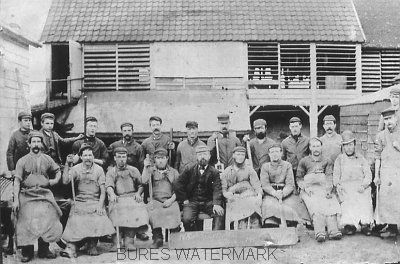|
THE LEATHER INDUSTRY
Economic and local historians have written a considerable amount about
the making of woollen textiles in East Anglia, but until recently have
tended to overlook other important sources of employment and wealth. In
Suffolk one of those 'forgotten' industries is the processing of hides
and skins, and their conversion into leather goods of many kinds.
No doubt the study of individual towns and villages will increase the
number of known leather workers. For example, the parish registers of
Halesworth from 1653 until the 1780s give occupations, including large
numbers of men engaged in the leather industry. However, most of them
were not wealthy enough to leave wills, nor did they enter into marriage
bonds.
Leather workers can be divided into two groups : those who prepared the
raw materials such as tanners and curriers, and a larger group such as
glovers, harness-makers and shoemakers who manufactured goods from treated
leather. Not surprisingly, the two groups show a very similar distribution
as they were closely reliant on each other. For the period from 1500 to
about 1750, the numbers of each type of craftsman found in the two sources
are as follows (again it should be stressed that the true numbers must
be considerably higher)
|
Crafts preparing
leather
|
Crafts using prepared
leather |
|
Tanners 216
|
Cordwainers 318
|
|
Fellmongers 32
|
Glovers 173
|
|
Knackers 30
|
Shoemakers 144
|
|
Curriers 23
|
Collarmakers 59
|
|
Skinners 15
|
Saddlers 50
|
|
Leather dressers
6
|
|
The working of hides and skins was, on the
whole, more urban-based than some other Suffolk industries. The principal
reason for this may be that the skins of cattle, horses and other animals
were most easily obtained in those places where large numbers of butchers
and knackers congregated on market days. The dominance of butchers as
holders of market stalls is noticeable in a number of towns such as Beccles
and Halesworth. Three towns stand out as particularly major centres of
the industry : in descending order of importance, they are Bury St Edmunds,
Ipswich and Beccles. Tanners required water for their operations so it
is not surprising that most of them lived in valleys. On the other hand,
in spite of their concentration in towns, the preparation and working
of leather were to be found in rural communities as well : they were widespread
throughout the county, particularly in the clay lands of High Suffolk
where cattle rearing and dairying were a major feature of local farming.
Not surprisingly they were less in evidence in the sheep rearing districts
of the Breckland and Sandlings.
Courtesy of Nesta Evans
|

